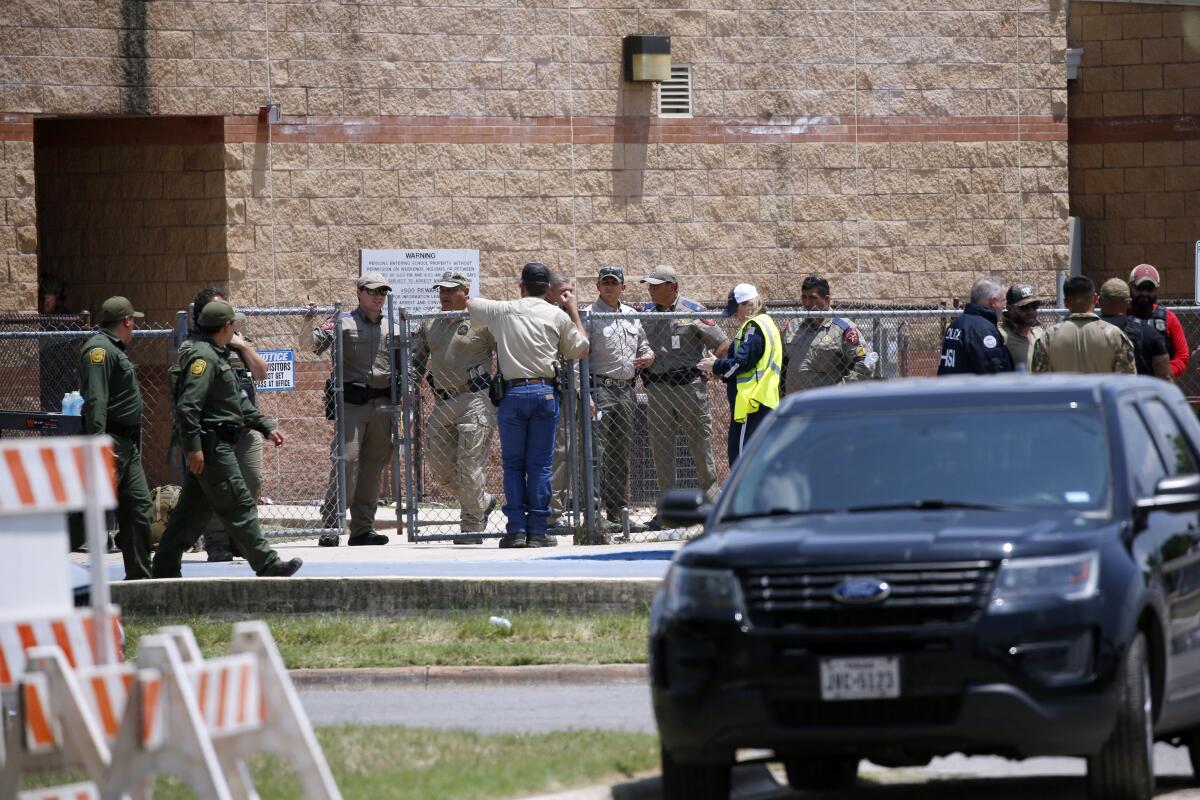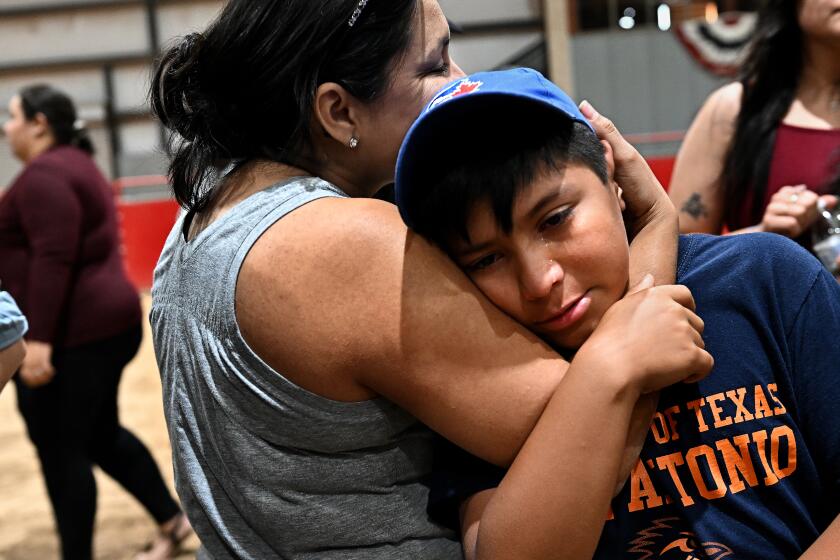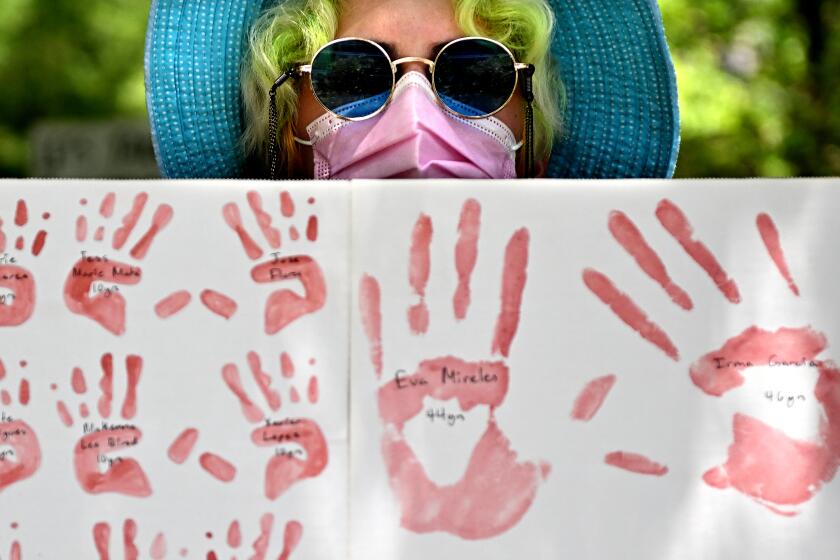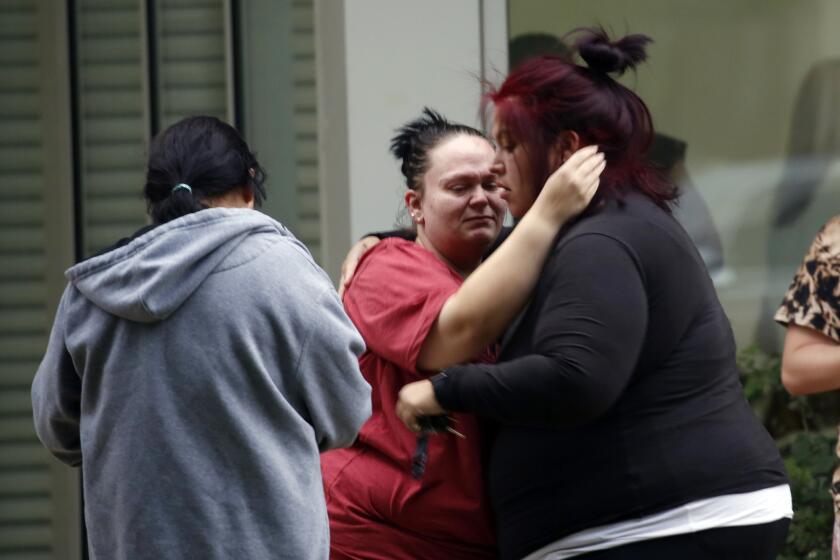Texas school shooting: How to help kids get through unspeakable horror

The shooting that left 19 children and two teachers dead at a school in Texas is forcing parents and schools to once again confront how to talk to kids about violence.
Experts have told The Times these are complex and sensitive conversations, but also vital — especially for the children of today, who’ve endured a pandemic.
“And now, on top of all those already existing pandemic-related chronic stressors, many children and families may be overwhelmed with the added fear of sending their children to school,” said Katherine Williams, a child and adolescent psychologist and professor of psychiatry at UC San Diego.
Here are some tips experts have suggested.
1. Check in with your child and talk to them about their concerns.
Mental health professionals advise that the first thing parents should do is make sure their child or adolescent knows they are willing and available to talk with them.
Always start with asking your child or teen what they’ve already heard about the event, Williams said. Parents can do this by asking open-ended questions and calmly addressing questions in a simple and developmentally appropriate way. Young children may have heard nothing about it, but older children may have watched news videos during the school day.
The gunman who killed 19 children and two teachers at a Texas elementary school barricaded himself inside a fourth-grade classroom, officials say.
Help your child to identify their feelings about the shooting, Williams said. A great way to do that is to model expressing how you feel about it. For example, you could say: “I’m feeling worried about those families in Texas. How are you feeling right now?” And then help the child find ways to cope with those difficult feelings, such as talking about the people who help in such tragedies.
2. Give kids a sense of control.
Kids may feel like the world is spinning out of control and that there’s not much they can do about it. But it’s important that they do not feel helpless, said Richard Weissbourd, a Harvard psychology professor whose work focuses on vulnerability and resilience in childhood.
This is especially true for teens, who are more prone to feeling disillusioned and cynical. Encourage your kids to convert “passivity into activity,” Weissbourd said. If they feel strongly about gun control or school safety, let them get involved in political action or advocacy. “Anything that will help them feel like they might have an impact on this problem, that it will be less likely to happen again if there is collective action, is really important.
Talk with adolescents about what it has taken to emerge from dark periods of history, and what our responsibility is in situations like this — that we “have to push for the change that we want,” Weissbourd said.
Younger kids can also send thank you notes to the paramedics, peace officers and teachers who helped to save lives at the school, “which in turn helps the child feel like they have hope, as well as some control in what feels like a scary world right now,” Williams said. “Children can also make cards with words of support to the other children at Robb Elementary School, which can help them to process their own feelings.”
2. Give kids reassuring facts about their safety.
Parents should immediately reassure children that they are safe — a practice that extends to all trauma survivors.
With younger children, adults can explain all that adults do to keep them safe, such as locking doors and conducting emergency drills.
Parents also can and should tell their children that school is a safe place for them.
3. Treat children according to their age.
Give young children only brief, simple information. These children are less verbal so they may communicate about their anxiety by drawing or playing. Answer their questions with specifics, but don’t overload them.
For middle- and high-school-age youth, more detailed conversations will be appropriate. The best place to have that conversation depends on the teen — it could be in the car or while a friend is present, instead of just sitting and talking about the event one on one.
The gunman posted his intentions on Facebook before shooting his grandmother, going to the elementary school and barricading himself in a classroom.
4. Limit exposure to the media.
This is true for youth of all ages. Violent images can cause secondary trauma. Symptoms of this in children include chronic fatigue, anger, poor concentration and fearfulness. And developmentally inappropriate information can cause anxiety and confusion. For younger children, “every time they watch the news, they feel like it’s a new event as opposed to repetition of the same event. It’s important for them not to watch too much,” Carol Vidal, a child and adolescent psychiatrist at Johns Hopkins University, told The Times in 2019.
While older kids will understand that difference, prolonged exposure to graphic images and details is harmful to them as well.
5. Model healthy behavior.
Children pick up everything their parents are saying and doing. Parents can set an example by turning off the television, radio or social media. It can be constructive for parents to acknowledge that constantly watching or hearing about a violent incident makes them too feel anxious or fearful.
But parents should make clear that they are handling their own emotions and that their child does not need to be strong for them, said Jonathan Vickburg, a licensed marriage and family therapist who treats kids dealing with trauma.
One way you can do this is by talking to other parents, Weissbourd said. Find out how they’re feeling and how they’re choosing to discuss the tragedy with their kids. “We’ve all been really wrecked by this, and we all need to increase our collective coping capacities and wisdom for how to move through it,” he said.
It’s natural to be anxious right now. But if you don’t manage your reactions, you might worsen or even jumpstart your child’s anxiety. Weissbourd recommends going for a walk, meditating, limiting news intake (especially distressing images), and hanging out with loved ones as coping strategies.
6. Maintain routines.
Sticking to regular routines can be reassuring and can help children and teens maintain a sense of normality.
That may be difficult in the hours and days immediately after a traumatic event, Vickburg said, but parents can still help their children put some order to their days — for example, by continuing to have dinner with family, doing homework, or hanging out with friends.
With teenagers in particular, giving them extra time to be with their friends is important. It helps them establish normality and connect to their support network.
After the Texas school shooting, dozens waited as officials took DNA samples to confirm whether their children were among the 19 killed.
7. Have a plan.
Review safety procedures at school and at home. Let children know whom to call, where to meet and how to communicate in case of an emergency. This helps children feel secure and know adults are in control.
8. Observe children’s emotional state and seek help if necessary.
The majority of children are resilient and will not experience long-term symptoms after a one-off event, experts said. Immediately after a violent incident they may experience anxiety and fear. Some people closer to the incident may also have difficulty sleeping or be jittery.
Watch for changes in behavior, mood, appetite or sleep. You should also look for avoidance of school, social isolation and increased tantrums, Williams said. When such symptoms persist over time and start affecting how a person functions, that’s when professional help may be needed.
More tips
The National Assn. of School Psychologists has guidelines for explaining violent events to children of different ages. It’s important, the experts say, to use age-appropriate language, and to answer questions without adding to confusion. From the NASP tip sheet:
- “Early elementary school children need brief, simple information that should be balanced with reassurances that their school and homes are safe and that adults are there to protect them.”
- “Upper elementary and early middle school children will be more vocal in asking questions about whether they truly are safe and what is being done at their school. They may need assistance separating reality from fantasy. Discuss efforts of school and community leaders to provide safe schools.”
- “Upper middle school and high school students will have strong and varying opinions about the causes of violence in schools and society…. Emphasize the role that students have in maintaining safe schools by following school safety guidelines ... communicating any personal safety concerns to school administrators, and accessing support for emotional needs.
The Los Angeles County Office of Education also offers these resources to help parents and educators:
- Parent Guidelines for Helping Youth After the Recent Shooting (The National Child Traumatic Stress Network)
- Helping Children Cope with Frightening News (Child Mind Institute)
- Coping in the Aftermath of a Shooting (American Counseling Association)
Former Times staff writers Nina Argawal and Sonali Kholi contributed to this report.
More to Read
Sign up for Essential California
The most important California stories and recommendations in your inbox every morning.
You may occasionally receive promotional content from the Los Angeles Times.














